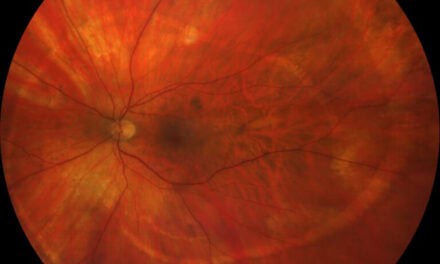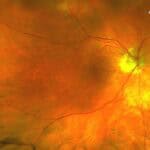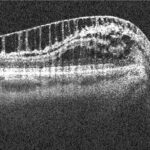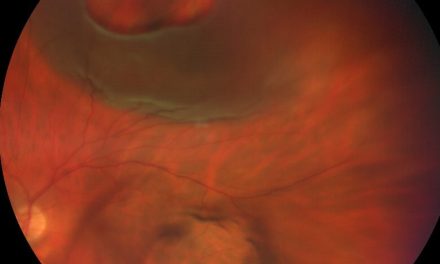
Asymptomatic Occipital Stroke Uncovered During Work-up For Optic Neuropathy

Welcome to the “Neuro Nuggets” column within the Journal of Medical Optometry! Many eye care providers find neuro-ophthalmic disease to be an intimidating area within our field – and rightfully so. The stakes are high. These diseases often are visually devastating and potentially life-threatening. This column aims to make these conditions more approachable by blending real-world clinical cases with evidence-based medicine. Whether neuro is something you are passionate about or a topic you usually shy away from, hopefully you find this column a worthy read and gain clinical pearls along the way. Enjoy!
CASE PRESENTATION:
A 73-year-old black male presented to the optometry clinic for eye exam. He denied any symptoms of visual loss or scotoma in the visual field of either eye. Review of systems was unremarkable. The patient’s past medical history included hypertension, hyperlipidemia, and post-traumatic stress disorder.
On examination, the patient’s best-corrected visual acuity was 20/20 in each eye. Pupillary testing revealed a mild positive relative afferent pupillary defect (RAPD) in the left eye with mild physiologic anisocoria right eye greater than left eye. There was also 25% relative red cap desaturation in the left eye compared to the right eye. Color vision testing via Ishihara was within normal limits in each eye. Visual fields by confrontation (finger counting) were suggestive of bilateral inferonasal restriction in each eye. Ocular motility and alignment evaluations were normal and orthophoric. There was no proptosis in either eye. Slit lamp biomicroscopy showed typical age-related anterior segment findings including mild nuclear sclerotic and cortical cataracts in each eye. Intraocular pressure was normotensive and symmetric. Dilated fundus evaluation revealed bilateral diffuse optic disc pallor, left eye greater than right eye. The maculae and retinae were otherwise within normal limits in each eye. Ancillary testing including optic disc photos, Humphrey visual field testing, and optical coherence tomography (OCT) were obtained (Figures 1–4).

Figure 1. Optic disc fundus photos at presentation. Note bilateral optic disc pallor.
The patient was assessed to have bilateral optic nerve pallor/atrophy (OS>OD). Extensive laboratory testing (Table 1) showed no obvious etiology for the patient’s optic neuropathy. Neuroimaging via magnetic resonance imaging (MRI) of the brain and orbits with and without contrast did not show evidence of any compressive optic neuropathy.
Further review of the patient’s medical history revealed a prior significant gastrointestinal bleed that required hospital admission, surgical intervention, and ostomy placement many years prior to presentation. At the time of the gastrointestinal bleed, the patient suffered significant blood loss with his hematocrit plummeting from 34% to 23%, and the patient endorsed visual symptoms during hospital admission. No formal eye exam was performed at that point given the patient’s overall medical status. Considering this newly uncovered history, a diagnosis of bilateral shock-induced ischemic optic neuropathy was made. It was decided to repeat the visual field testing to document his baseline afferent visual function and serially monitor for any progression.
At follow-up one month after initial presentation, the patient remained entirely asymptomatic and denied any ocular/visual or systemic symptoms. Repeat Humphrey visual field testing revealed a new left superior homonymous hemianopic (congruous) paracentral visual field defect (Figure 2). There was a high level of concern for a new right occipital lobe lesion given this pattern on visual field testing, and the patient was urged to seek immediate neurologic evaluation and repeat neuroimaging to assess for stroke.

Figure 2. Serial Humphrey visual field 24-2 examinations from presentation to 12-month follow-up.
The patient was admitted, and a cardiovascular/stroke work-up was initiated. Repeat MRI of the brain revealed a subacute right inferior medial occipital stroke, corresponding to the patient’s left superior homonymous hemianopic (congruous) paracentral visual field defect (Figure 5). There was also evidence of chronic lacunar infarcts in multiple areas of the brain including the cerebellar hemispheres. Cardiology evaluation including Holter monitor did not show any evidence of atrial fibrillation, but a patent foramen ovale (PFO) was identified during a bubble study. After multi-disciplinary discussion and serial exams, it was ultimately decided to maintain the patient on maximally tolerated medical therapy that included cholesterol/lipid optimization, low-dose aspirin, and short-term anti-platelet therapy. Long-term anticoagulation was deferred given the patient’s prior gastrointestinal bleed. Surgery to close the PFO was deferred. The occipital stroke was ultimately felt to be likely cardioembolic in nature.

Figure 3. OCT RNFL scan. Note multiple areas of RNFL thinning in each eye, most prominent superotemporally.

Figure 4. OCT Posterior Pole scan with Ganglion Cell Layer (GCL) Segmentation. Note superotemporal GCL thinning in each eye.

Figure 5. MRI brain/orbits, T1 FLAIR sequences before (left) and after (right) gadolinium contrast showing intense gyriform enhancement in the inferior medial right occipital lobe consistent with a subacute infarct.
Serial eye exams showed stable optic disc appearance and function without any progression. The left superior homonymous hemianopic (congruous) paracentral visual field defect largely resolved twelve months after initial presentation, and visual function remained stable.
DISCUSSION
Eye care providers are uniquely positioned to screen the visual pathway using commonplace techniques, including visual field evaluation. This patient showcases two pivotal roles that optometry plays: 1) identification and work-up of optic neuropathy and 2) advocating for appropriate work-up and neuroimaging when there is a compelling, localizing visual field defect.
Shock-induced ischemic optic neuropathy is commonly associated with acute blood loss, particularly after gastrointestinal bleeding or surgery. Resultant visual loss may occur between days to weeks after the acute insult and is often bilateral. The acute blood loss commonly results in optic disc pallor, and the prognosis for visual recovery is guarded.1,2
An estimated 50-60% of the surface area of the visual cortex in the occipital lobe is devoted to the central ten degrees of vision.3 This means that lesions here often produce characteristic visual field loss. In particular, the homonymous hemianopic central scotoma seen in this patient most commonly localizes to either the occipital tip or the medial area of the occipital lobe. Knowing the anatomy is critical, as this can help guide neuroimaging studies and direct the attention of radiologists to specifically assess for lesions. While many patients with occipital lesions may present with complete homonymous hemianopia, a study of over 800 patients with occipital lesions by Zhang et al. found that the majority (62%) had partial or incomplete homonymous hemianopia and that most (~70%) were a result of thromboembolic stroke.4,5 Fortunately, visual recovery after acute stroke is possible, and approximately 50% of patients attain at least some visual field recovery.
CLINICAL PEARLS:
- Shock-induced ischemic optic neuropathy is often associated with prior gastrointestinal bleeds, and patients with optic disc pallor should be questioned about any history of prior surgery or blood loss.
- Visual field testing plays a vital role in identification and localization of visual pathway lesions.
- Most occipital lobe lesions are due to cerebral infarction.
- Multi-disciplinary care and communication is of paramount importance in patient management.
REFERENCES:
- Foroozan R, Buono LM, Savino PJ. Optic disc structure and shock-induced anterior ischemic optic neuropathy. Ophthalmology. 2003 Feb;110(2):327-31. doi: 10.1016/S0161-6420(02)01736-0. PMID: 12578776.
- Al Othman BA, Naser M, Kini AT, Lee AG. Restricted Diffusion in the Optic Nerve Head After Shock-Induced Anterior Ischemic Optic Neuropathy. J Neuroophthalmol. 2021 Mar 1;41(1):e114-e115. doi: 10.1097/WNO.0000000000000897. PMID: 32028450.
- Ogawa K, Ishikawa H, Suzuki Y, Oishi M, Kamei S. Clinical study of the visual field defects caused by occipital lobe lesions. Cerebrovasc Dis. 2014;37(2):102-8. doi: 10.1159/000356848. Epub 2014 Jan 16. PMID: 24435066.
- Zhang X, Kedar S, Lynn MJ, Newman NJ, Biousse V. Natural history of homonymous hemianopia. Neurology. 2006 Mar 28;66(6):901-5. doi: 10.1212/01.wnl.0000203338.54323.22. PMID: 16567709.
- Zhang X, Kedar S, Lynn MJ, Newman NJ, Biousse V. Homonymous hemianopias: clinical-anatomic correlations in 904 cases. Neurology. 2006 Mar 28;66(6):906-10. doi: 10.1212/01.wnl.0000203913.12088.93. PMID: 16567710.
Dr. Kane graduated from New England College of Optometry in 2015 and went on to complete an ocular disease/primary care residency at VA Boston Jamaica Plain from 2015-2016. He is currently an attending optometrist at VA Boston. His interests include clinical teaching, neuro-ophthalmic disease, retinal vascular disease, glaucoma, and ocular manifestations of systemic disease.
